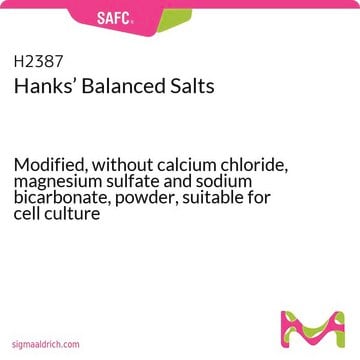H9394
Solution saline équilibrée de Hank solution
Modified, with sodium bicarbonate, without calcium chloride and magnesium sulfate, liquid, sterile-filtered, suitable for cell culture
Synonyme(s) :
HBSS
About This Item
Produits recommandés
Stérilité
sterile-filtered
Forme
liquid
Technique(s)
cell culture | mammalian: suitable
Impuretés
endotoxin, tested
Composants
NaHCO3: 0.35 g/L
glucose: 1.0 g/L (Dextro)
phenol red: 0.011 g/L
Conditions d'expédition
ambient
Vous recherchez des produits similaires ? Visite Guide de comparaison des produits
Description générale
Application
- as a component of the culture medium for culturing of mouse cortical slices
- as a component of the dissociation buffer for incubation of human-induced pluripotent stem cells (hiPSCs) and hiPSC-derived cardiomyocytes (CMs)
- for in situ perfusions of mice liver
Actions biochimiques/physiologiques
Supplément
Code de la classe de stockage
12 - Non Combustible Liquids
Classe de danger pour l'eau (WGK)
WGK 1
Point d'éclair (°F)
Not applicable
Point d'éclair (°C)
Not applicable
Certificats d'analyse (COA)
Recherchez un Certificats d'analyse (COA) en saisissant le numéro de lot du produit. Les numéros de lot figurent sur l'étiquette du produit après les mots "Lot" ou "Batch".
Déjà en possession de ce produit ?
Retrouvez la documentation relative aux produits que vous avez récemment achetés dans la Bibliothèque de documents.
Les clients ont également consulté
Protocoles
StableCell™ Trypsin solutions are designed to perform cell detachment as standard trypsin solutions do, without the need to aliquot, freeze, and thaw. This saves significant time before passaging.
Trypsin is commonly used for dissociating adherent cells from surfaces. A wide variety of trypsin solutions are available to meet your specific cell line requirements.
Notre équipe de scientifiques dispose d'une expérience dans tous les secteurs de la recherche, notamment en sciences de la vie, science des matériaux, synthèse chimique, chromatographie, analyse et dans de nombreux autres domaines..
Contacter notre Service technique






